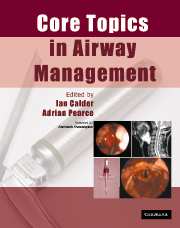Book contents
- Frontmatter
- Contents
- List of contributors
- Preface
- Acknowledgements
- List of abbreviations
- 1 Anatomy
- 2 Physiology of apnoea and hypoxia
- 3 Physics and physiology
- 4 Cleaning and disinfection of airway equipment
- 5 General principles
- 6 Maintenance of the airway during anaesthesia: supra-glottic devices
- 7 Tracheal tubes
- 8 Tracheal intubation of the adult patient
- 9 Confirmation of tracheal intubation
- 10 Extubation
- 11 Light-guided intubation: the trachlight
- 12 Fibreoptic intubation
- 13 Retrograde intubation
- 14 Endobronchial and double-lumen tubes, bronchial blockers
- 15 ‘Difficult airways’: causation and prediction
- 16 The paediatric airway
- 17 Obstructive sleep apnoea and anaesthesia
- 18 The airway in cervical trauma
- 19 The airway in cervical spine disease and surgery
- 20 The aspiration problem
- 21 The lost airway
- 22 Trauma to the airway
- 23 Airway mortality associated with anaesthesia and medico-legal aspects
- 24 ENT and maxillofacial surgery
- 25 Airway management in the ICU
- 26 The airway in obstetrics
- Index
Preface
Published online by Cambridge University Press: 15 December 2009
- Frontmatter
- Contents
- List of contributors
- Preface
- Acknowledgements
- List of abbreviations
- 1 Anatomy
- 2 Physiology of apnoea and hypoxia
- 3 Physics and physiology
- 4 Cleaning and disinfection of airway equipment
- 5 General principles
- 6 Maintenance of the airway during anaesthesia: supra-glottic devices
- 7 Tracheal tubes
- 8 Tracheal intubation of the adult patient
- 9 Confirmation of tracheal intubation
- 10 Extubation
- 11 Light-guided intubation: the trachlight
- 12 Fibreoptic intubation
- 13 Retrograde intubation
- 14 Endobronchial and double-lumen tubes, bronchial blockers
- 15 ‘Difficult airways’: causation and prediction
- 16 The paediatric airway
- 17 Obstructive sleep apnoea and anaesthesia
- 18 The airway in cervical trauma
- 19 The airway in cervical spine disease and surgery
- 20 The aspiration problem
- 21 The lost airway
- 22 Trauma to the airway
- 23 Airway mortality associated with anaesthesia and medico-legal aspects
- 24 ENT and maxillofacial surgery
- 25 Airway management in the ICU
- 26 The airway in obstetrics
- Index
Summary
Every anaesthetist will reach the end of his/her career with a collection of difficult airway experiences.There can be few more terrifying experiences in medical practice than the realization that a cyanosed patient is getting worse, not better, particularly when the patient was nice and pink before the anaesthetic began. Many seasoned anaesthetists recognize the change that comes over trainees after their first experience of serious difficulty with the airway. One of the editors remembers a conversation with a distinguished American paediatric anaesthetist about the difficulty of keeping up with bright young residents. Her observation that ‘a few deep paediatric desaturations sure does take the shine off'em’ was correct. All of us who have been around for some time have ‘been there’, and we know we could find ourselves in difficulty any time we give an anaesthetic.
Management of the airway of patients who are sedated, obtunded or anaesthetized is the responsibility of nursing and medical practitioners in anaesthesia, emergency medicine, intensive care medicine and other critical care areas. Anaesthetists do not own the airway and their right to be considered expert can be based only on good clinical practice, knowledge of relevant basic science and critical evaluation of every component of airway care.
There is an uneasy combination of science and art in airway management. We know a good deal about the physics and physiology, but are less certain about the safest way to manage the airway in many patients. Meetings of the Difficult Airway Society have often been lacking in consensus, sometimes confusing, but always educational. It is probably just that there really are several ways to pluck a chicken.
- Type
- Chapter
- Information
- Core Topics in Airway Management , pp. ix - xPublisher: Cambridge University PressPrint publication year: 2005
- 1
- Cited by



